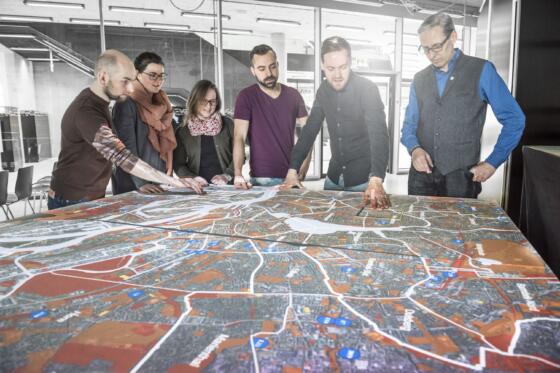The power of soft
Electrification, connectivity, the Internet of Things: We’re used to automobiles having become part of those ecosystems. But what are the implications for automotive development? Will it continue to be evolutionary? Or is that development as disruptive as it has been in the IT industry, the retail sector, with music or with movies? The electronics architecture in fact has an increasingly stronger impact on the development process of cars.
Expert Maria Anhalt names transformation fields.
Changes in customer wishes
For about a century, powerful performance or economy, sportiness or ride quality were typical criteria according to which customers would judge and buy automobiles. However, with a younger generation, other user experiences are gaining the upper hand. What’s the focus today? Maria Anhalt says, “Customers are no longer focused only on horsepower but on the in-vehicle experience. The ‘digital life experience,’ the desire for software-based experiences has increasingly become a driver in the automotive industry. Capgemini Consulting estimates that from 2021 to 2031 leading automakers are going to nearly triple their software-based sales, from a share of eight percent in total sales to 22 percent.”
A look at China underscores the expert’s statements. There, young people are already spending more than 90 minutes per day in a car – not for moving from A to B but for surfing, gaming and communicating in the parked vehicle.
Inverse approach to basic structure
The digital advance in passenger cars has a major impact on business models and development organizations in the automotive sector: instead of component-based solutions with integrated software, cross-domain software solutions must be created. That’s why software architects are gaining clearly more influence on product development. Maria Anhalt: “A transformation like that, which in this kind of relevance occurs only once in 30 years, requires extensive rethinking, a new mindset: the time of lone wolves is over – collaboration and new alliances are crucial for persisting in times of change.”
New brands like Tesla are already thinking and designing cars in ways that don’t start with the chassis but implement an innovative electrical-electronic (E/E) architecture right from the beginning. Is that an opportunity for new market players? Maria Anhalt says it is and provides an example: “Elektrobit partners with the new Sony Honda Mobility (SHM) joint venture. For the new EV prototype AFEELA, the software was created first, followed by the hardware – that’s completely new. Elektrobit developed not only the software architecture for the user experience but also co-designed the cockpit system such as the software for high-performance processors from Qualcomm. The car was created within the space of two years around innovative software and not developed by hardware engineers. The software, the user experience and connectivity marked the beginning of the project – everything else, including the hardware, was subordinated to that, which put the collaboration between Sony Honda Mobility and us on a level playing field. Tech giants like Microsoft, Meta or Apple are moving in – boosted by software. Sooner or later, other leading tech corporations are going to appear with proprietary products but they’ll need a lot of staying power to do so.”
Changes in supply chains
The disruptions in automotive development are so fundamental that it’s safe to assume that the business models of individual market players are going to clearly change. So far, the spotlight has been on component-based software. Be it the engine, the transmission, convenience functions or thermal management, each assembly used to have a dedicated control unit with dedicated software. Up to 150 of those units are installed in a modern automobile. That “sectionalism” of the software map is going to disappear, Anhalt is sure. Instead, cross-domain solutions are going to emerge, which means that software architects are going to influence product development at a clearly earlier stage than before.
Maria Anhalt: “For years, attention has been focused on the Automotive Operating System (Automotive OS), which is far more than an operating system. It encompasses an entire environment for the development of software for vehicles, cloud ecosystems, data management, development tools, update and upscale systems, and more. This environment must encompass real-time and safety and security requirements as well as attractive customer-oriented features for entertainment and driver assistance. An Automotive OS as a standardized mediating layer between software and hardware will position itself accordingly also in the supply chains: in other words, between automotive OEMs and classic tier-1 suppliers. Consequently, Elektrobit increasingly supplies directly to the automotive industry as well.”
The importance of cross-corporate solutions
Just like in the case of all technological disruptions and innovations, when it comes to new vehicle architectures, the question arises: shared standards or individual OEM solutions? Maria Anhalt has detected the following trend: “60 percent of the software in an automobile is non-differentiating. That means it’s generic, irrespective of the brand. That’s a strong argument in favor of a standardized approach. The wheel doesn’t need to be reinvented with major cost and resource consumption when viable solutions are available. Via the remaining 40 percent, brand-specific special characteristics can be defined. We firmly believe in open-source software as a potential game changer.”
Cybersecurity of automobiles
In the wake of growing digital interaction with extensive software ecosystems, data security of vehicles as well as access authorizations are becoming increasingly important too. Cybersecurity must be guaranteed as well as the personal rights of users in the spirit of data ownership. Maria Anhalt says, “The big difference results from the partial update capability of the control units. Software components are integrated in the vehicle only as a result of a software update – as opposed to the integration of complete control unit software at the time of the development and for installation by trained personnel. Obviously, new attack vectors that must be considered open up along this update chain. The development standards are prepared for that and the remainder of the basic conditions have been adjusted accordingly by the UNECE Cybersecurity Regulations.”

“With updates, and particularly with upgrades, of the software, the car is always state-of-the-art and therefore more stable in value.”
Benefits for the consumer
The new architectures require less complex cable harnesses, development and manufacturing are simplified and over-the-air updates reduce costs. Even so, Maria Anhalt doesn’t expect new cars to become cheaper for consumers. She says, “These benefits apply primarily to production. The development costs aren’t going to noticeably decrease because the requirements for safety and cybersecurity are going to increase. That means we’ll tend to see the creation of value shift from hardware to software so that the benefit for the customer will tend to be more in the value proposition. With updates, and particularly with upgrades, of the software, the car is always state-of-the-art and therefore more stable in value. In addition, maintenance costs can be expected to go down because the new architectures are less complex and new features can be offered to customers.”
Apps for automobiles
It’s apparent that the “Function on demand” option opens up new business segments for car manufacturers: technologies have been pre-installed and can be activated for an extra charge. Can OEMs continue to change their previous business models due to new architectures? Aside from incorporating new business segments like these into existing OEM process structures, Maria Anhalt sees another big hurdle: “In the case of smartphones, two ecosystems, Android and iOS, were basically able to establish themselves. In the automotive sector, we’re currently counting 15 software platforms. De facto standards are urgently needed to develop an ecosystem – or adequate quantities produced by individual manufacturers. The smart TV market can serve as a negative example. Many manufacturers developing a proprietary app ecosystem were not inclined to maintain it across several appliance generations. In addition, they had no business model enabling them to monetize the development of the apps for their platforms. Those are the obstacles that must be overcome.”
Challenges during the transition
Manufacturers are currently using their existing platforms with traditional control unit architectures while developing new software platforms. Maria Anhalt says, “A software platform is a stand-alone software product requiring continuing further development irrespective of the lifecycle of the hardware below it. To use the smartphone analogy once more: no one would come up with the idea of asking when the end of the lifecycle for iOS is planned. Although the further development of individual versions is discontinued in the course of time and new versions are released the objective is not to close the project. Unlike control unit projects, a software platform is not developed with a dedicated final date. However, at the moment, many manufacturers are heavily mixing these lines of thinking. That becomes apparent whenever such software platforms are supposed to be rolled out to several vehicle generations.”
Classic engineering
The idea of developing an automobile starting with the software architecture creates the impression of a competitive situation with traditional engineering know-how. Will chassis, vehicle dynamics or body construction be less important than software in the future? Should students of engineering select different specializations? Maria Anhalt evaluates the developments like this: “The ambition to design and build safe, powerful and attractive vehicles continues unabated. In fact, the further development of the electrical-electronic (E/E) architecture and software-controlled functionality – especially when considering the potential effects of highly developed autonomous functions – will open up completely new possibilities of vehicle design and space utilization. If as an engineering student I were to think about a future in the mobility sector I’d no doubt see ample opportunities in the fields of informatics and electronics.”
The expert

Maria Anhalt (born in 1970) is CEO of Elektrobit Automotive GmbH. Among other subjects, she studied computer science and general management in Sofia, Bulgaria, at K.I.T in Karlsruhe, Germany, and at Harvard and Stanford Universities in the United States. In her previous career, Maria Anhalt served in various roles in senior management, business development and as head of research & development at Hewlett Packard Enterprise, Micro Focus and Continental. While holding those positions, she evolved into a forward-looking leader who drives innovations and pursues unprecedented pathways to success.


